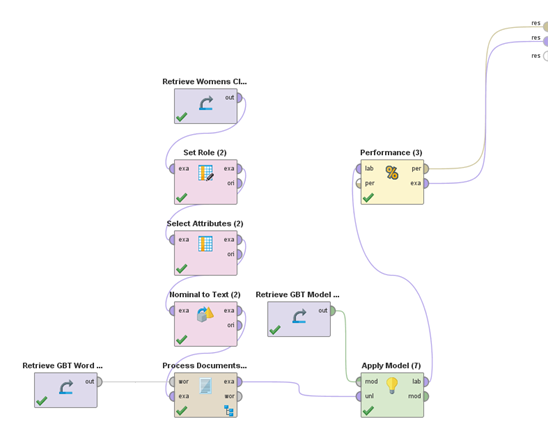Predict Product Success using NLP models
 Contributor II
Contributor II
A tutorial on predicting the next trend in a fashion e-Commerce context
 Image by James Wheeler
Image by James Wheeler
Prerequisites
Experience with the specific topic: Novice
Professional experience: No industry experience
Knowledge of machine learning is not required, it would help if the reader is familiar with basic data analysis. All concepts in the article are explained in detail from scratch for beginners. To follow along, download the sample datasethere. This tutorial explains a business application of Natural Language Processing for actionable insights.
Introduction to Natural Language Processing and Business use cases
A very simple definition that is commonly found online for Natural Language Processing (NLP) is that it is the application of computation techniques on language used in the natural form, written text or speech, to analyse and derive certain insights from it. These insights could vary quite widely, from understanding the sentiment in a piece of text to identifying the primary subject in a sentence.
The complication of the analysis can also range from simple to very complex. For instance you may want to categorise pieces of text, say from Twitter data, as having positive sentiment or negative sentiment. On the other hand you may want to extract product suggestions/complaints from product review data from a large dataset to figure out new product launch strategies. The work being done on chatbots, to understand text queries and respond to them; spam detection, etc. falls in the ambit of NLP.
This field can encompass many applications and thus many techniques, which makes it a fairly large topic. For this particular tutorial we will be discussing in detail a business case application of NLP, to derive practical and actionable insights in the e-commerce domain.
Understanding the Business scenario
For this tutorial a dataset available on Kaggle, from the e-commerce fashion domain, is used. This is available at:https://www.kaggle.com/nicapotato/womens-ecommerce-clothing-reviews
This dataset seems fairly typical of most e commerce marketplaces, and so it is a good representation. It is a dataset that has numerical rating data as well as text reviews of several items of clothing for women. The items have a “Clothing ID” which is a unique identifier. There are two kinds of ratings — a numerical 1 to 5 for product rating and another rating of 1 or 0 for recommend the product or not, a binomial attribute i.e it has only two possible values. There are also other attributes that describe the category of the item, the age of the reviewer etc. If you think about it, these attributes provided in this dataset are very typical of most such online shopping portals. In fact, this is not restricted only to the fashion domain and so the techniques applied here should be extendable to other domains as well.
With this dataset, it would be interesting to explore if the text reviews can predict whether the item would trend or not. That would be pretty useful information for a fashion business. If such insight was accurately available about a product the product or category manager can make sound decisions on the product’s inventory strategy, promotions etc. This is our business problem.
So the aim is to have an automated system, that can analyse the initial few reviews by customers of a new product and predict if the newly launched product will succeed or not. With this information the products inventory can be built up and it can be pushed through the supply chain. This way one can implement soft product launches and respond to the market’s acceptance of the product.
The two tools used for this experiment are Excel and Rapidminer. There are two parts to this workflow. First some feature engineering, carried out in excel, then the actual model training and testing, carried out in Rapidminer.
Part 1: Feature Engineering in Excel
With the data given, we need to first arrive at a mathematical definition for “trending product”. At this stage is where domain knowledge of the business comes in handy. We know that if a product is doing well and if customers are happy with it, they take the effort to write positive reviews about it. People generally tend to write detailed reviews either if they are very happy or very dissatisfied with the item. If they are happy, they tend to write good reviews and rate it highly. Also, products that do well get many reviews, and most reviewers would have a similar opinion of the product with high ratings.
To translate this mathematically; the product’s success has a direct relation between number of reviews, average rating of the product, and has an inverse relation with the standard deviation of the ratings for the product. That is if the market likes it, a lot of customers tend to rate it highly without much variation. We can create a new feature based on this understanding.

Borrowing from the tanh activation function used in neural network training, we can define a new feature “Rating Strength” as below.
Rating Strength = (Rating Factor)²
Where,

Where, “Reviews proportion” is the proportion of reviews that item received from the full dataset
Average and std deviations are self-explanatory.
This creates a new feature with values between 0 and 1. Values closer to 1 get assigned to items where there have been a large number of reviews, the ratings have been good and there is very low variance in the ratings, i.e everyone has rated it well. Values closer to 0 are assigned for items which did not generate much excitement — the number of reviews are few and ratings are low with high variance. The main aim of this mathematical definition was to get a numerical feature that represents the product’s success and preferably with values between 0 and 1, rather than unscaled large values.
这二项标签您可以创建一个叫做“Item_success”, with two possible values “Trending” or “Not trending”, where “Trending” is assigned to items with Rating Strength above a certain cutoff and “Not trending” is assigned to items below this cutoff value. For this dataset I picked a cutoff value of 0.00036. This cutoff was determined by simply looking at the dataset, however there could be better automated ways of doing this. This manual decision, however, was a very simple and quick solution. For a person working with these products in question it would be a fairly straight forward decision. Below is a snippet of the dataset.

Feature engineered dataset (snippet)
This creation of a new feature in the dataset from available features is called feature engineering. It’s a useful step that can be deployed to machine learning problems. All of the activity till here was carried out in Microsoft Excel. The next part is the development of a model to predict this binomial label that we created. The predictive modelling part was carried out in Rapidminer.
Part 2: Predictive Modelling in Rapidminer
Setup
This part was carried out in Rapidminer. The problem is basically of language processing. Given a new review we want to make a prediction if that item would trend or not. There is certainly information contained in the language of a review that can give clues on whether the item will succeed. Given past data, we should be able to predict for new items being reviewed.
Essentially, we need to use past data to build a model that can learn from the language of reviews for known successful products, and use this learning on new reviews of future products to predict its chances of success.
The process flow used in Rapidminer is shown below:
 Model training in Rapidminer
Model training in Rapidminer
Rapidminer is a very easy to use machine learning platform and is ideal for business managers who may not be data scientists but are keen on quick application of these techniques to their business requirements. In Rapidminer each operation can simply be carried out by dragging and dropping the related operator into the workspace and connecting the input data graphically. You can visualise the data flowing and getting processed in each stage in the above diagram.
Let us go through each of the operators used above:
1.Retrieve: We first need to retrieve the dataset that we created in part 1. For this either we can read the excel file itself or first import the data into Rapidminer and then access it. In this case we are doing the latter. The data will have to be imported first, which is pretty straightforward and there is a wizard to do the import step by step, you can start the import by clicking on the “Add Data” button in Rapidminer. In the Retrieve operator’s settings we then define the name of the dataset, defined during import, to be accessed.
2.Sample: The dataset contains close to 19,500 rows. But we don’t want to use the full dataset. It will be time consuming and could lead to over fitting. So in the sample operator we can define how many samples to select. I have chosen 4500 samples.
3.Set Role: We need to define which of the features is of interest to us, the one we want to predict. For us it is the “Item_success” column, we define this feature as thelabel. The label is the feature that needs to be predicted.
4.选择属性: In our dataset we had defined new columns like average rating, standard deviation of rating, proportion of reviews etc. to arrive at the “Item_success” feature. It is very important to remove these features from the training data that will be supplied to train the model. This is very important. These columns will not be available for future real time data and including them here could give false accuracy levels and a model that will not function in deployment. You can go through the excel file to understand these columns better. So the features actually selected are as below:
Age
Class Name
Department Name
Division Name
Item_success
Rating
Recommended IND
审查文本
Title
All of these features will be available for new data during deployment.
5.名义上的文本: This is a data type converter. We use this to convert the审查文本成文本数据类型。这是necessary for the next operator in the process.
6.过程s Documents: This is a crucial step in such text classification applications. This is a nested operator, i.e there is a process within this operator as shown below:
 过程s flow to generate n-Grams
过程s flow to generate n-GramsIt breaks down the text into tokenised n-grams, here n was set to 2. These n-grams become part of the bag of words that the model later uses to understand the relationship between the words in the review and the label feature. Tokenizing the document, stemming and filtering out stopwords (like a, an, the etc.) are standard practices. The stemmed tokens are all transformed to lower case and we filter out tokens which have lesser than 5 characters of more than 25 characters. Finally the 2-Grams are generated creating a large bag of phrases. This is the primary data that the model learns from.
7.Store: A store operator is used to store the word list generated from the Process documents step. This will have to be used while applying the learnt model on new data. This is an important point to remember.
8. Split Validation: The next task is to train and test the model. The Split Validation operator is used for this. This is again a nested operator. It splits the data into training and test data and uses the trained model on the test data. The internal process of this operator is shown below:
 Split validation sub-process
Split validation sub-processThe Gradient Boosted Trees is used here, the trained model is stored for future use using again the Store operator as shown above. The Apply Model operator applies the trained model on the test portion of the data and the Performance Binomial Classification operator is used to measure the performance of the model on the test data. The Performance operator generates a 2x2 table with details of the classification predicted by the model and the actual classification.
Training and evaluation
The next stage after setting up the process in Rapidminer is to try out various models and see what gives good results. This is the part where you actually train your machine learning model.
There are several algorithms that can be tried. It is usually good practice to start with the simple models like k-NN. The k-NN technique is the simplest possible model and can be used in almost all machine learning problems. This helps you set a good benchmark against which you can then try more advanced techniques. With Rapidminer it is as easy as replacing the Gradient Boosted Trees model shown in the figure above with any other predictive model of your choice by right clicking the operator and choosing the replacement. Of course not all models will work for all situations. Some models accept only numerical data. The best way to go about this stage is trial and error, and with practice things will be clear.
 Replacing an operator for trials
Replacing an operator for trials
The results obtained for the k-NN model is shown below.

Continuing the process the following models were tried and corresponding results of those models are given below.

Naive Bayes results

Decision Tree results



The GBT results for the larger dataset is given below:

GBT results for wider dataset
Being able to predict the chances of success of products like this can be very useful in planning inventory and distribution. Perhaps success rate across demographics and geographic locations can be predicted, that can be very useful in planning for the right distribution of products. As with any model, it is important to test it further by running it in parallel with live data to further optimize the accuracy of the model. Such applications clearly show the utility of such techniques and their prevalence is only going to increase.
Once the trained model and word list are stored it can be reused for application to new data. This would involve obtaining the new products’ review and rating data in the same format as in training data and replace the first operator, in the process shown above for applying the learnt GBT model, with the new data. Run the process and see what the predictions are. A category manager handling a wide array of products can run this process at a set frequency, the system will help point him in the right direction and in a matter of only few minutes. Of course there are ways to output the predicted data into an excel file that can be circulated to the team to help them take decisions on the supply chain aspects of their products.
There are still ways to further improve on the system. Perhaps instead of mathematically defining successful products, if data can be mined that provides the actual success or failure of the product the accuracy can be improved. In this tutorial we have created a technique based on available data, one can even try a different approach of sourcing rich data knowing the workflow that can be used, this will also require some work on enabling such data creation and collection, but could be the most accurate. Having prior knowledge of how the data will be used and how the machine learning system works using NLP is very useful in designing the data collection and preparation process.
In summary, we have implemented a quick model based on NLP that predicts a product’s chances of success based on text reviews of the product. Such a system can help a category manager handle a large number of products and SKUs. The time consumed to apply the model on new data is just a matter of minutes or even seconds and this can be taken advantage of at a high frequency. The Rapidminer processes, dataset and results are available at thisGithub repository.





Comments